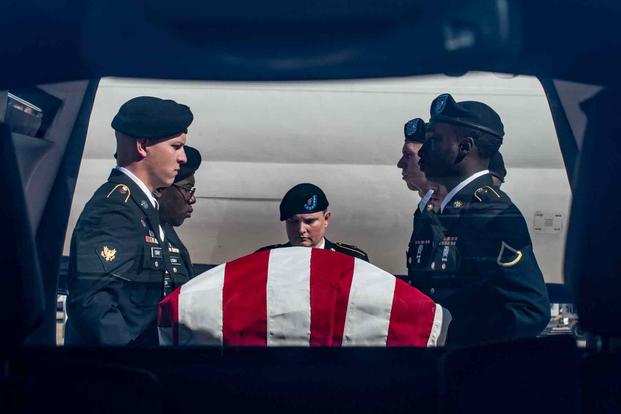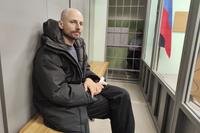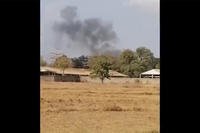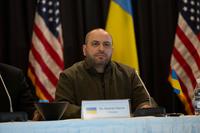One by one, the relatives of troops lost in the Korean War rose to tell in heart-wrenching detail why it was still so important for them and the nation, even after more than 70 years since their loved ones went missing, to identify their remains and bring them home.
"Danny Boy" will always be their song, said Brenda Lott, sister of Army Cpl. Daniel Dulin, who served with I Co., 3rd Battalion, 187th Regimental Combat Team. He was killed in action near the North Korean town of Opar-ri on Oct. 21, 1950, and is still unaccounted for, according to the Defense POW/MIA Accounting Agency, or DPAA.
"He was 18 years old" when he was lost, "and I was 6. He was my first love and my first grief," Lott said. "Sometimes people ask, 'Why do you keep doing this? It must be hard to keep doing this," going to briefings and pressing for answers, she said. "I say, 'No, it isn't hard. He's my brother.'"
Read Next: Pentagon Set to Allow Calculator Use on Military Entrance Exam as Recruiting Slumps
Another who told of her family's loss was Tracy Kramer, whose uncle, Pvt. 1st Class Wayne Franklin Elliott, went missing in action against the enemy on Oct. 29, 1952, while serving with G Co., 2nd Battalion, 179th Infantry Regiment, 45th Infantry Division.
Kramer said her father had "no acceptance of his brother's passing," and her mother kept sending him care packages even after the military declared he was dead. As for herself, Kramer said, "It's hard to believe you can miss someone you've never met so badly."
Kramer and Lott were among more than 500 family members of missing troops from the Korean War who attended an annual two-day DPAA briefing for them at an Arlington, Virginia, hotel on the status of efforts to identify remains already in DPAA custody and the thus-far fruitless attempts to get North Korea to allow renewed searches of known sites where Americans are believed to have fallen or were buried.
The DPAA total count for missing U.S. service members after the war was 8,157. The total that has been identified and accounted for was 665, leaving about 7,492 still unaccounted for, although that number has been changing.
DNA and forensics specialists with the DPAA and Armed Forces Medical Examiners Office were still working off the 55 boxes of remains turned over by North Korea as part of the "Singapore Summit" between then-President Donald Trump and North Korean dictator Kim Jong Un in 2018.
DPAA has also received permission from the Defense Department to disinter the remains of 872 service members from the Korean War who were buried as unknowns at the National Memorial Cemetery of the Pacific in Honolulu, known as the "Punchbowl."
At the meeting for the families Thursday, retired Army Master Sgt. Dominga Briones, of Victoria, Texas, held up a photo of the uncle she never knew -- Pvt. 1st Class Adelaido M. Solis, her mother's brother.
Solis served with B Co., 1st Battalion, 9th Infantry Regiment, 2nd Infantry Division and was reported missing in action on Dec. 1, 1950, after his unit's withdrawal from Kunu-ri, North Korea. He is believed to have died in North Korean prisoner of war Camp No. 5 in April 1951, and he was among those buried as an unknown at the Punchbowl.
Last September, DPAA announced that Solis' remains had been identified through a combination of dental and anthropological analysis, and mitochondrial DNA analysis by the Armed Forces Medical Examiner. His funeral and burial last October in South Texas was at the San Jose Cemetery near Bloomington, Texas.
"He was 19 years old" and from a farming family, Briones said of her uncle Adelaido, and he had an older brother, Axildo Solis, who also served in Korea and came home to tell his younger brother that he should enlist.
"Mom always had pictures of the two brothers" on display in the house, Briones said, and from what she had heard of her uncle Adelaido, "he was a carefree soul, always kidding around."
In his remarks to the families and at a media roundtable, retired Air Force Maj. Gen. Kelly McKeague, the DPAA director, said there were three main sources for possible identifications of the missing from the Korean War -- remains recovered between about 1990 and 2005 when North Korea periodically allowed U.S. teams to search, the 55 boxes of remains turned over in July 2018 and the current disinterments from the Punchbowl.
"This is a very challenging, very complex mission" to account for the missing, McKeague told the families, and "we also share your frustration" at the slow progress in making identifications due to what he called "forces beyond our control" that "prevent us from giving you the answers you deserve."
The main obstacle was North Korea's refusal to cooperate or even communicate with DPAA on the possibility of resuming searches in North Korea, McKeague said.
In July 2018, when North Korea turned over 55 boxes of remains, McKeague was confident that U.S. recovery teams would soon be allowed to conduct searches there.
"Our collective goal is to commence field operations in the DPRK [Democratic People's Republic of Korea] next spring," McKeague said at the time.
"We have not yet reached an agreement with the DPRK regarding future field recoveries. However, we are working closely with our DoD, State Department, and National Security Council partners on this matter," he said in a statement to the National League of POW/MIA Families and veterans groups.
But what had been seen as a possible opening to improved relations with North Korea quickly fell apart. McKeague said there were two meetings at Panmunjom in the Demilitarized Zone on renewed recoveries, with the last coming in March 2019, and there has been no contact since then.
"Sadly for us, every channel used since March 2019" has been a dead end," McKeague said, and the result is that some families can be optimistic that identification can be made from the remains on hand while others will be "less optimistic," but there is a possibility, "still a possibility," for the families that an accounting eventually will be made.
Mary Liverman has been clinging to that possibility over the decades for "Uncle Charles," Pvt. Charles E. Dewees, a recipient of the Silver Star who served with C Co., 1st Battalion, 38th Infantry Regiment, 2nd Infantry Division, and went missing on Sept. 30, 1951.
She recalled his last day at home spent at the beach in Long Beach, Calif., before leaving for the war. "I was 3 years old, but I remember snippets. My dad and Uncle Charles and Mom spread out blankets," and Uncle Charles "even let us bury him in the sand."
The next day, Charles was in uniform and pictures were taken. "Tears rolled down my grandmother's face," Liverman said, and as a young girl, she didn't quite understand what was happening. "The handshakes were so strong" among the men, she said, and she recalled her father telling Charles, "Do good, take care of yourself and come back to your mom and me. He said he would."
Then the family stood outside to watch the car that was taking Charles away to the war until it disappeared from view, Liverman said.
-- Richard Sisk can be reached at Richard.Sisk@Military.com.













